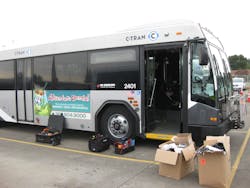WSTIP Awarded TRB IDEA Grant to Study and Evaluate Collision Avoidance Technology
We’ve all seen the commercial — a woman enjoying a country drive suddenly finds her car skidding to a stop, barely avoiding a collision with the truck in front of her. She didn’t make her car do that. Her car did that on its own. Her car is equipped with collision avoidance technology designed to anticipate a road hazard faster than a human can and take evasive action. Industry chatter suggests this kind of technology could eliminate nearly all passenger vehicle accidents.
If collision avoidance technology can work on passenger vehicles, could it work on transit buses? The Washington State Transit Insurance Pool just received a $100,000 IDEA grant from the Transportation Research Board (TRB) to help them find out.
The IDEA Grants, according to TRB, “provide start-up funding for promising, but unproven, innovations in surface transportation systems. The program’s goals are to seek out and support new transportation solutions that are unlikely to be funded through traditional sources.”
The study’s estimated total cost will be $225,000, and it will take about16 months to complete. In addition to the TRB grant, WSTIP will contribute almost $80,000 of its own funds toward the pilot. Other funding partners include Munich Re, which contributed $37,000, and Government Entities Mutual and Alliant Insurance Services, which each contributed $5,000. Munich Re is a leading worldwide reinsurer; GEM is a captive reinsurance company for public entities throughout the United States, and Alliant is a leading insurance broker focused on public entities.
This potentially life-saving technology will be tested on 35 buses, distributed throughout seven transit providers in Washington State. Unlike the car in the commercial, however, this technology will not take control of the bus. Instead, it is intended to alert transit drivers in time for them to take corrective action on their own.
Bus collisions with pedestrians or cyclists have been difficult to prevent when the bus itself obscures the driver’s range of view. Bus pillars can easily block a driver’s view of pedestrians and cyclists while moving through an intersection. Pedestrians and cyclists can unknowingly move into a blind spot somewhere along the side of the bus as the bus is turning or merging into or out of traffic.
Forward-motion accidents are also a challenge. In especially congested and complex corridors, driver attention is demanded in a multitude of directions. A driver may not respond quickly enough when a vehicle stops suddenly in front of the bus. A simple rear-ender between two passenger vehicles can be relatively minor, but one involving a bus can be catastrophic.
These two types of accidents, bus/pedestrian (or cyclist) and forward-motion, can have devastating consequences. Lives can be permanently harmed or lost altogether. The transit driver involved may never recover emotionally from the event. Liability costs are typically immense in these kinds of accidents. While these costs may be covered by insurance, the cost of insurance inevitably goes up. That increased cost must be covered by funds that could have been used to improve service to the community, so the entire community suffers.
Utilizing transit liability loss data (2004 to 2014) from Washington State, the Ohio Transit Risk Pool and the California Transit Indemnity Pool, Munich Re was able to determine these transit entities incurred $191 million in losses during this 10 year time frame, that’s over $19 million a year. In that $191 million of losses, $113 million was for claims over $100,000 and $78 million was for claims under $100,000.
According to WSTIP, almost 90 percent of the large (over $100,000) collision-related transit losses that it tracks are forward-motion accidents or collisions with pedestrians, bikers and motorcycle riders. The premise of this study is that most of these accidents could be preventable if collision avoidance technology was available on buses.
WSTIP is proposing that audio and visual warning systems on transit buses will avoid collisions by increasing the transit operator’s awareness of and response to impending collision conflicts.
WSTIP will oversee the study. Dr. Yinhai Wang, Director of the Pacific Northwest Transportation Consortium at the University of Washington and Dr. Jerome Lutin are the principal investigators for this study. They will provide data evaluation and analysis. Steve Clancy from Geneva Financial Services will assist with grant management, administration and project coordination.
The seven largest transit providers in WSTIP’s membership will participate, with a total of 35 buses involved. The participating member transit agencies are: Ben Franklin Transit, C-Tran, Community Transit, Intercity Transit, Kitsap Transit, Pierce Transit and Spokane Transit. Additionally, King County Metro will participate.
Because this study relies heavily on the participation of transit operators, WSTIP is working closely with operators to make sure there is acceptance on the part of drivers. “We’re not to a place yet where drivers are comfortable with a collision avoidance system that takes control of the bus,” according to WSTIP Deputy Director Jerry Spears, who conceived the study. “So we’ve kept the focus of this study on early warning systems that the driver can respond to directly.”
WSTIP will be testing a collision avoidance system integrating smart vision sensors manufactured by Mobileye® and driver interfaces manufactured by ROSCO® Vision Systems. ROSCO, founded in 1907, is one of North America’s largest bus mirror manufacturers, and a vision safety leader in backup camera systems, camera recording systems, mirrors and sun visors in numerous commercial vehicle markets. Mobileye is a technological leader in the area of software algorithms, system-on-chips and customer applications that are based on processing visual information for the market of driver assistance systems. The Collision Avoidance System, called Mobileye® Shield+ Pedestrian and Cyclist Safety Technology, will include cameras mounted on the sides and front of the bus; adjustable-volume, audible warning systems for transit drivers and pedestrians, and LED warnings to alert transit drivers when a hazard is imminent. Each time a potential collision is averted, data (including video footage) will be recorded and transmitted for analysis.
A key premise of the study is that retrofitting buses now and in the future is preferable to waiting for collision avoidance equipment to become standard on new buses. While some bus manufacturers are exploring how to include collision avoidance systems in new buses, the technology is changing rapidly and can become obsolete just as rapidly. Further, according to the FTA, the minimum expected life of a transit bus is 12 years, but many remain in service for up to 18 years. At that rate, it could take decades to bring this technology into transit fleets; and the technology will evolve far more rapidly than buses can be replaced.
“If we can standardize and provide specifications for retrofitable systems, then acquiring, maintaining, updating and repairing them will likely be much more affordable and timely,” Spears said. “A retrofitable approach also helps more companies get in the game. The potential for multiple sources of equipment should stimulate innovation and help reduce costs.”
For decades, bus transit providers have worked to make bus travel one of the safest forms of transportation. From 2002 to 2011, there has been a significant decline in the number of injuries per year. The rate of injuries per million passenger miles has also significantly decreased. However, these statistics mask a disturbing trend: a significant increase in casualty and liability expense. According to the National Transit Database, the total expense for such claims has increased an average of nearly three percent per year. In 2011 alone, bus transit agencies nationwide reported 3,260 collisions, 12,928 injuries and 92 fatalities, resulting in reported casualty and liability expenses totaling over $483 million. This amounts to an annual average casualty and liability cost of $8,069 per bus. Over that same 10-year period, the transit industry, which is largely self-insured, spent nearly $4.2 billion on casualty and liability expenses.
The cost of transit injury claims is primarily reported in insurance reserves and claim payments by the insurance carriers, not the transit agencies. The transit agencies only reflect insurance premiums and deductibles. As a result of the actuarial pooling of potential loss figures, the impact of transit accidents and injury is not fully reflected in transit agencies year over year. This accounting convention provides a greater incentive for the insurance industry to pilot the implementation of collision avoidance technology.
“This idea quickly caught the interest of Munich Re, leading them to partner with us in the study,” Spears said.
Currently, an autonomous collision avoidance package for a Mercedes sedan costs $2,800. If a similar system that can be adapted for transit buses at about the same price per bus, the overall casualty and liability savings could be substantial. If they see even a 35-percent reduction in collisions, the cost of the system could be recovered in a year. More importantly, the public – including riders, pedestrians and other motorists – will be safer.
The Mobileye Shield+ technology, integrated with Rosco’s engineered solutions and featured in the study will alert drivers when an obstacle is within the path of the bus. The alert, both audible (voice alert) and visual (strobe light), will activate automatically. When a pedestrian or object triggers the alert and a collision is avoided, onboard cameras will capture the incident. The transit driver will also submit his or her own report regarding what happened. Additionally transit operators and riders will be surveyed to capture first-person feedback, and transit operators will participate in focus group discussions. Transit operators will be asked to provide feedback regarding the usefulness and/or distracting quality of the visual and auditory warnings. The operator will also be asked to report the number of false alerts, if any.
The video and other data will be relayed directly to Dr. Wang at the University of Washington, who will evaluate each incident to determine whether and how the equipment helped the driver avoid a collision. Dr. Wang and Dr. Lutin will collaborate on producing a document for the TRB IDEA program that reviews, explores and evaluates the installation, the operation, the human factors and the analytics that result from piloting this innovative safety solution.
Ultimately, the study will provide best-practice, standardized interfaces, allowing multiple vendors to develop modular and updatable systems and components,” according to Steve Clancy, coordinator of the project.
While the FTA has conducted earlier studies involving collision avoidance systems, the technology at the time had not reached the level of sophistication or affordability now available to the light vehicle market. The advancements available in passenger vehicles now put development of a similar system for buses within reach. There are also a handful of smaller studies currently under way using the same equipment, but none are on the scale of the WSTIP study.
If the study generates the results WSTIP is hoping for, they will begin working with member transit agencies, the federal transit administration and the Washington State public transportation department to retrofit current transit fleets and make collision avoidance equipment a mandatory requirement on future bus builds.
“We are very optimistic about this study,” Spears said. “The lives and heartache that could be spared boggles the mind. And that doesn’t even take into account the advancements we can put in place if revenue set aside for these liabilities could instead be available for service.
WSTIP is a 25 member self-insurance program for most public transit systems within Washington state. Combined, its member agencies drive over 100 million miles a year. WSTIP insures over 4,700 employees, 5,000 vehicles and over 10,000 volunteers. The mission of WSTIP is to reduce members’ cost of risk. The WSTIP Board recently adopted a strategic plan that includes a commitment to evaluate and test possible technology-based engineering solutions to some of their most vexing losses. WSTIP views this technology testing effort as a multi-year, loss-prevention endeavor, looking at a range of innovative solutions to manage and mitigate member risk.
Jerry Spears is the deputy director of the Washington State Transit Insurance Pool (WSTIP).
About the Author

